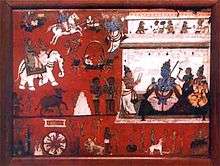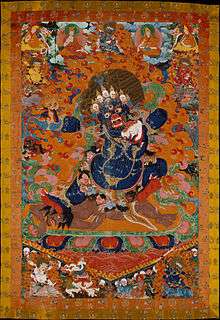Yama
| Yama | |
|---|---|
| God of Death, Underworld and Spirits | |
 Yama's Court and Hell. The Blue figure is Yama with his twin sister Yami and Chitragupta. A 17th-century painting from the Government Museum in Chennai | |
| Affiliation | Deva |
| Abode | Naraka |
| Mantra | Om yamaya namah |
| Weapons | Lasso, Mace |
| Mount | Water Buffalo |
| Greek equivalent | Hades |

Yama or Yamarāja, also called Imra,[1] is a god of death, the south direction and the underworld,[2] belonging to an early stratum of Rigvedic Hindu deities. In Sanskrit, his name can be interpreted to mean "twin".[3] In the Zend-Avesta of Zoroastrianism, he is called "Yima".[4] According to the Vishnu Purana, his parents are the sun-god Surya[5] and Sanjna, the daughter of Vishvakarman. Yama is the brother of Sraddhadeva Manu and of his older sister Yami, which Horace Hayman Wilson indicates to mean the Yamuna.[6] According to Harivamsa Purana her name is Daya.[7] There is a temple in Srivanchiyam, Tamil Nadu dedicated to Yama.
In the Vedas, Yama is said to have been the first mortal who died. By virtue of precedence, he became the ruler of the departed,[8] and is called "Lord of the Pitrs".[9]
Mentioned in the Pāli Canon of Theravada Buddhism, Yama subsequently entered Buddhist mythology in Tibetan and East Asian Buddhism as a dharmapala under various transliterations. He is otherwise also called as "Dharmaraja".
Hinduism

In Hinduism,[10] Yama is the lokapala ("Guardian of the Directions") of the south and the son of Brahma. Three hymns (10, 14, and 35) in the 10th book of the Rig Veda are addressed to him. He has two dogs with four eyes and wide nostrils guarding the road to his abode (cf. hellhound). They are said to wander about among people as his messengers.[11]
According to Hindu mythology Yama is the son of Surya and Saranyu. He is the twin brother of Yami, brother of Shraddhadeva_Manu and the step brother of Shani.[12]
Buddhism
In Buddhism, Yama (Sanskrit: यम) is a dharmapala (wrathful god) said to judge the dead and preside over the Narakas ("Hells" or "Purgatories") and the cycle of rebirth.
The Buddhist Yama has however, developed different myths and different functions from the Hindu deity. He has also spread far more widely and is known in every country where Buddhism is practiced, including China, Korea, Vietnam and Japan.
Abode
Naraka (Hindu)
Naraka in Hinduism serves only as a temporary purgatory where the soul is purified of sin by its suffering. In Hindu mythology, Naraka holds many hells,[13] and Yama directs departed souls to the appropriate one. Even elevated Mukti-yogyas and Nitya-samsarins can experience Naraka for expiation of sins.
Although Yama is the lord of Naraka, he may also direct the soul to a Swarga (heaven) or return it to Bhoomi (earth). As good and bad deeds are not considered to cancel each other out, the same soul may spend time in both a hell and a heaven. The seven Swargas are: Bhuvas, Swas (governed by Indra), Tharus, Thaarus, Savithaa, Prapithaa, and Maha (governed by Brahma).
Naraka (Sikhism)

The idea of Naraka in Sikhism is like the idea of Hell. One's soul, however, is confined to 8.4 million life cycles before taking birth as a human, the point of human life being one where one attains salvation, the salvation being sach khand. The idea of khand comes in multiple levels of such heavens, the highest being merging with God as one. The idea of Hell comes in multiple levels, and hell itself can manifest within human life itself. The Sikh idea of hell is where one is apart from naama and the Guru's charana (God's lotus feet (abode)). Without naama one is damned. Naama is believed to be a direct deliverance by God to humanity in the form of Guru Nanak. A Sikh is hence required to take the Amrit (holy nectar/water) from gurubani, panj pyare (khanda da pahul) to come closer to naama. A true Sikh of the Gurus has the Guru himself manifest and takes that person into sach khand.
Naraka (Buddhist)
Naraka is usually translated into English as "hell" or "purgatory". A Naraka differs from the hells of western religions in two respects. First, beings are not sent to Naraka as the result of a divine judgment and punishment; second, the length of a being's stay in a Naraka is not eternal, though it is usually very long. Instead, a being is born into a Naraka as a direct result of his or her previous karma (actions of body, speech and mind), and resides there for a finite length of time until his karma has exhausted its cumulate effect.
Chinese and Japanese mythology

Mandarin Diyu, Japanese Jigoku, Korean Jiog, Vietnamese Địa ngục literally "earth prison", is the realm of the dead or "hell" in Chinese mythology and Japanese mythology. It is based upon the Buddhist concept of Naraka combined with local afterlife beliefs. Incorporating ideas from Taoism and Buddhism as well as traditional religion in China, Di Yu is a kind of purgatory place which serves not only to punish but also to renew spirits ready for their next incarnation. This is interchangeable with the concept of Naraka.
In Japanese mythology, Enma-O or Enma Dai-O judges souls in Meido, the kingdom of the waiting dead. Those deemed too horrible are sent to Jigoku, a land more comparable to the Christian hell. It is a land of eternal toil and punishment. Those of middle note remain in meido for a period awaiting reincarnation. Others, of high note, become honored ancestors, watching over their descendants.
Related concepts
Yama and Ymir
In a disputable etymology, W. Meid (1992) has linked the names Yama (reconstructed in Proto-Indo-European as *yemos) and the name of the primeval Norse frost giant Ymir, which can be reconstructed in Proto-Germanic as *umijaz or *jumijaz, in the latter case possibly deriving from PIE
- ym̥yos, from the root yem "twin". In his myth, however, Ymir is not a twin, and only shares with Yama the characteristics of being primeval and mortal. However, Ymir is a hermaphrodite and engenders the race of giants.
In Iranian mythology
A parallel character in Iranian mythology and Zoroastrianism is known as Yima Xšaēta, who appears in the Avesta. The pronunciation "Yima" is peculiar to the Avestan dialect; in most Iranian dialects, including Old Persian, the name would have been "Yama". In the Avesta, the emphasis is on Yima's character as one of the first mortals and as a great king of men. Over time, *Yamaxšaita was transformed into Jamšēd or Jamshid, celebrated as the greatest of the early shahs of the world. Both Yamas in Zoroastrian and Hindu myth guard hell with the help of two four-eyed dogs.[14][15]
In Javanese culture
There is Yamadipati in Javanese culture, especially in wayang. The word adipati means ruler or commander. When Hinduism first came to Java, Yama was still the same as Yama in Hindu myth. Later, as Islam replaced Hinduism as the majority religion of Java, Yama was demystified by Walisanga, who ruled at that time. So, in Javanese, Yama became a new character. He is the son of Sanghyang Ismaya and Dewi Sanggani. In the Wayang legend, Yamadipati married Dewi Mumpuni. Unfortunately, Dewi Mumpuni fell in love with Nagatatmala, son of Hyang Anantaboga, who rules the earth. Dewi Mumpuni eventually left Yamadipati, however.
In Buddhist temples
In the Buddhism of the Far East, Yama is one of the twelve Devas, as guardian deities, who are found in or around Buddhist shrines (Jūni-ten, 十二天).[16] In Japan, he has been called "Emma-ten".[17] He joins these other eleven Devas of Buddhism, found in Japan and other parts of southeast Asia: Indra (Taishaku-ten), Agni (Ka-ten), Yama (Emma-ten), Nirrti (Rasetsu-ten), Vayu (Fu-ten), Ishana (Ishana-ten), Kubera (Tamon-ten), Varuna (Sui-ten) Brahma (Bon-ten), Prithvi (Chi-ten), Surya (Nit-ten), Chandra (Gat-ten).[17][18][19]
See also
- Death (personification), which also discusses the Grim Reaper
- List of death deities
- Time and fate deities
- Psychopomp
- Lord of Light
- Mrtyu
- Hades
- Pluto
- Thanatos
- Hell
- Norns, the Fates in Norse mythology
- Moirai, the Fates in Greek mythology
- Laima
- Dalia (mythology)
- Giltinė
- Osiris
References
| Wikimedia Commons has media related to Yama. |
- ↑ Minahan, James B. (10 February 2014). Ethnic Groups of North, East, and Central Asia: An Encyclopedia. ABC-CLIO. p. 205. ISBN 9781610690188.
Living in the high mountain valleys, the Nuristani retained their ancient culture and their religion, a form of ancient Hinduism with many customs and rituals developed locally. Certain deities were revered only by one tribe or community, but one deity was universally worshipped by all Nuristani as the Creator, the Hindu god Yama Raja, called imr'o or imra by the Nuristani tribes.
- ↑ Ancient History Encyclopedia. Yama.
- ↑ Puhvel, Jaan (1989). Comparative Mythology. Baltimore and London: Johns Hopkins University Press. pp. 285–286. ISBN 978-0801839382.
- ↑ F. Max Müller (Editor): The Zend-Avesta Part III, page 232
- ↑ Effectuation of Shani Adoration pg. 10-15.
- ↑ H.H. Wilson: The Vishnu Purana Volume 1, page 384
- ↑ Shanti Lal Nagar: Harivamsa Purana Volume 2, page 281
- ↑ A.A. MacDonnell, Vedic Mythology pg. 172.
- ↑ Shanti Lal Nagar: Harivamsa Purana Volume 1, page 85
- ↑ ^ a b c Shulman pp.36-9, 41
- ↑ Rigveda 10.14.10-12.
- ↑ Effectuation of Shani Adoration pg. 10 at https://books.google.com/books?id=RnzLgxvmOFkC&pg=PA9&dq=shani+karma&cd=2#v=onepage&q=shani%20karma&f=false
- ↑ Srimad Bhagavatam SB 5.26.3
- ↑ "Indian Myth and Legend: Chapter III. Yama, the First Man, and King of the Dead". sacred-texts.com.
- ↑ Sherman, Josepha (August 2008). Storytelling: An Encyclopedia of Mythology and Folklore. Sharpe Reference. pp. 118–121. ISBN 978-0-7656-8047-1.
- ↑ Twelve Heavenly Deities (Devas) Nara National Museum, Japan
- 1 2 S Biswas (2000), Art of Japan, Northern, ISBN 978-8172112691, page 184
- ↑ Willem Frederik Stutterheim et al (1995), Rāma-legends and Rāma-reliefs in Indonesia, ISBN 978-8170172512, pages xiv-xvi
- ↑ Adrian Snodgrass (2007), The Symbolism of the Stupa, Motilal Banarsidass, ISBN 978-8120807815, pages 120-124, 298-300